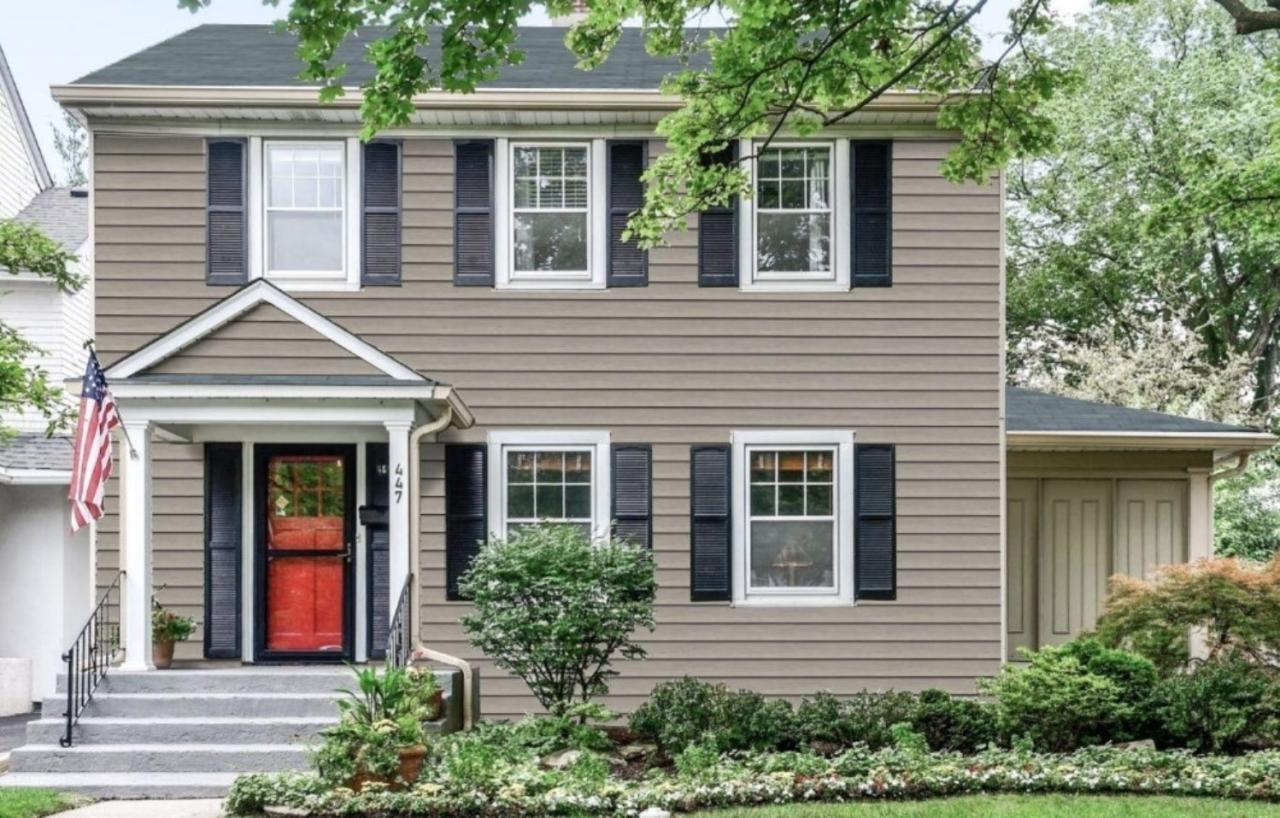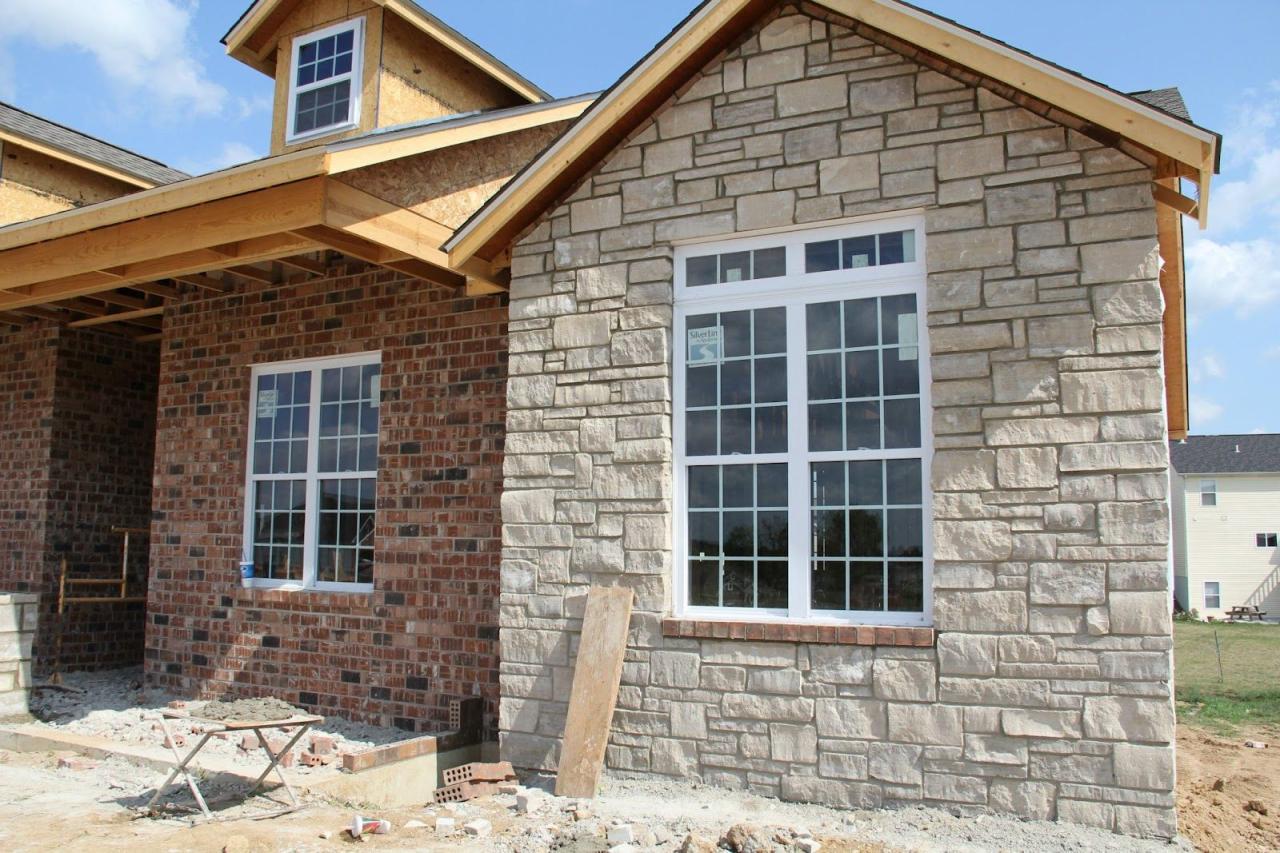Siding with brick houses opens up a world of possibilities for homeowners looking to enhance the aesthetic appeal of their exteriors. By combining different siding materials with the timeless charm of brick, a unique and eye-catching look can be achieved.
Let's delve into the fascinating realm of siding options that perfectly complement brick facades.
As we navigate through the various types of siding materials, color combinations, installation processes, and maintenance tips, you'll discover the key aspects of siding with brick houses that can transform any ordinary home into a standout masterpiece.
Introduction to Siding with Brick Houses

Siding with brick houses involves combining brick exteriors with siding materials to enhance the overall look and durability of a home. This approach allows homeowners to enjoy the classic appeal of brick while also benefiting from the versatility and customization options that siding provides.
Benefits of Combining Siding with Brick
- Enhanced Durability: Brick is known for its longevity and low maintenance, while siding materials can offer additional protection against the elements.
- Design Versatility: By incorporating siding options such as vinyl, fiber cement, or wood, homeowners can achieve various styles and textures to complement the brick facade.
- Increased Energy Efficiency: The combination of brick and siding can improve insulation and reduce energy costs for heating and cooling.
Popular Siding Options for Brick Facades
Some popular siding options that work well with brick exteriors include:
- Vinyl Siding:Affordable, low maintenance, and available in a wide range of colors to complement the brick.
- Fiber Cement Siding:Durable, fire-resistant, and can mimic the look of wood or stucco for a classic appeal.
- Wood Siding:Offers a natural and rustic look that can enhance the charm of a brick house.
Types of Siding Materials
Brick houses offer a timeless and classic look that can be enhanced with the right siding material. Let's explore different types of siding materials that pair well with brick exteriors, considering durability and aesthetic appeal.
1. Vinyl Siding
Vinyl siding is a popular choice due to its affordability and low maintenance requirements. When paired with brick, vinyl siding can provide a clean and modern contrast. It is durable and resistant to rot, making it a practical option for homeowners looking for a cost-effective solution.
2. Fiber Cement Siding
Fiber cement siding is a durable option that can mimic the look of wood or stucco. When combined with brick, fiber cement siding offers a striking visual appeal. It is resistant to insects, fire, and rot, making it a long-lasting choice for homeowners seeking a high-end finish.
3. Wood Siding
Wood siding adds warmth and natural beauty to a brick house, creating a charming and rustic aesthetic. While wood siding requires more maintenance compared to other materials, it can be stained or painted to complement the brick exterior. It is important to properly maintain wood siding to ensure its longevity.
4. Stone Veneer Siding
Stone veneer siding can enhance the texture and visual interest of a brick house. When paired together, brick and stone create a sophisticated and luxurious look. Stone veneer siding is durable and weather-resistant, adding both style and durability to the exterior of a home.
Color Combinations
When it comes to siding with brick houses, choosing the right color combination is essential to enhance the overall aesthetic appeal of your home. The siding color should complement the natural tones of the brick while adding visual interest and curb appeal.One tip for selecting siding colors that harmonize with brick tones is to consider the undertones present in the brick.
For example, if your brick has warm red undertones, choosing siding in shades of beige, cream, or tan can create a cohesive look. On the other hand, if your brick has cooler gray undertones, opting for siding in shades of gray or blue can provide a complementary contrast.
Contrasting vs. Complementary Color Choices
When deciding on color combinations for siding with brick homes, you can either choose contrasting colors for a bold and striking look or opt for complementary colors for a more harmonious and cohesive appearance.
- Contrasting Colors: Pairing a light-colored siding with dark brick can create a dramatic contrast that makes your home stand out. For example, a crisp white siding against deep red brick can create a striking visual impact.
- Complementary Colors: Choosing siding colors that are in the same color family as your brick but slightly lighter or darker can provide a cohesive and elegant look. For instance, if your brick has earthy brown tones, selecting a siding color in a similar warm brown hue can create a unified and inviting aesthetic.
Installation Process

When it comes to installing siding on a brick house, there are several key steps involved in the process. Siding can enhance the curb appeal and protection of your home, but it's essential to follow the right procedures, especially when dealing with brick exteriors.
General Steps for Installing Siding on a Brick House
- Preparation: The first step involves preparing the brick surface by cleaning it thoroughly and ensuring it is free of any debris or damage.
- Waterproofing: Next, a waterproof barrier is applied to the brick to protect it from moisture and prevent any water infiltration.
- Installation of Furring Strips: Furring strips are then installed over the brick surface to create a flat and even base for the siding to be attached.
- Siding Installation: The siding panels are finally installed over the furring strips, following the manufacturer's instructions and ensuring a secure and proper fit.
- Finishing Touches: Once the siding is in place, finishing touches such as trim pieces and caulking are added to complete the installation.
Special Considerations and Challenges
- Compatibility: It's crucial to ensure that the siding material you choose is compatible with brick and can be properly installed without causing damage.
- Ventilation: Proper ventilation is essential when adding siding to brick exteriors to prevent moisture buildup and potential issues like mold or rot.
- Expansion Gaps: Brick houses can expand and contract with temperature changes, so leaving expansion gaps in the siding installation is vital to prevent buckling or warping.
Hiring Professionals for Siding Installation
- Expertise: Hiring experienced siding professionals who have worked with brick exteriors before can ensure a smooth and successful installation process.
- Quality Work: Professionals can guarantee high-quality workmanship, proper installation techniques, and attention to detail for a long-lasting siding solution.
- Time and Cost-Effective: While hiring professionals may involve an upfront cost, it can save you time, effort, and potential rework in the long run by getting the job done right the first time.
Maintenance and Care
When it comes to maintaining and caring for siding with brick houses, it is essential to follow specific guidelines to ensure the longevity and aesthetic appeal of your home. Proper maintenance not only preserves the integrity of the siding materials but also protects the underlying brick structure.
Here are some tips for maintaining and caring for siding with brick houses:
Maintenance Requirements
- Regular Cleaning: Depending on the type of siding material used, regular cleaning with a mild detergent and water can help remove dirt, grime, and mold buildup.
- Inspection: Periodically inspect the siding for any signs of damage, such as cracks, warping, or loose panels, and address them promptly to prevent further deterioration.
Preserving Integrity
- Sealing Gaps: Ensure that any gaps or cracks between the siding and brick are properly sealed to prevent moisture infiltration, which can lead to mold growth and structural damage.
- Trimming Vegetation: Trim any overhanging branches or foliage near the siding to prevent damage from falling debris and to promote air circulation around the house.
Frequency of Maintenance
- Annual Inspection: Conduct a thorough inspection of the siding and brick components at least once a year to identify any issues early on and address them before they escalate.
- Seasonal Maintenance: Certain maintenance tasks, such as cleaning and sealing, may need to be performed seasonally to ensure the longevity of the siding materials and brick structure.
Closing Summary
In conclusion, siding with brick houses offers a blend of durability, visual appeal, and customization that can elevate the overall look of any property. By carefully selecting the right siding materials and colors, homeowners can create a stunning facade that stands the test of time.
Embrace the beauty and practicality of siding with brick to make a lasting impression with your home's exterior.
User Queries
What are some popular siding options that work well with brick houses?
Some popular siding options that complement brick facades include vinyl, fiber cement, and wood.
How do you choose siding colors that harmonize with brick tones?
When selecting siding colors, consider the undertones of the brick and opt for shades that either match or create a pleasing contrast.
What maintenance tasks are required for siding with a brick house?
Maintenance for siding with a brick house typically involves regular cleaning, inspections for damage, and repainting or sealing as needed.


